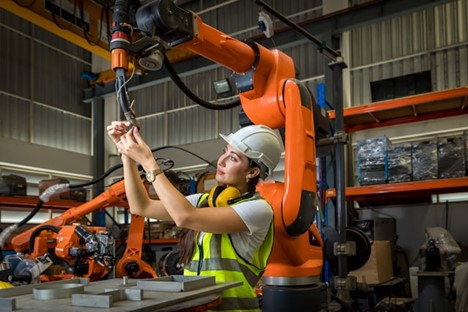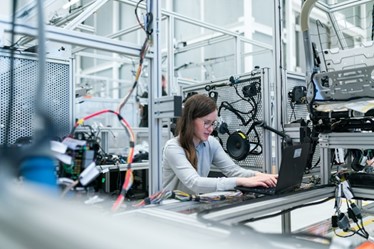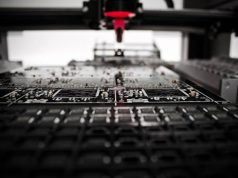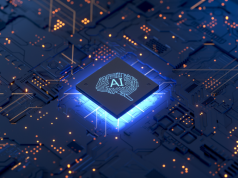Hannah Rudland is an entrepreneur in the tech industry. In the article below, Hannah Rudland discusses the myriad of ways in which AI is transforming industries and employment, paving the way for a future defined by automation, augmentation, and adaptation.
In modern society, artificial intelligence now stands at the forefront of technological innovation, reshaping industries, redefining business models, and revolutionizing the nature of work itself. From healthcare and manufacturing to technology and logistics, the transformative power of AI across diverse sectors has become evident, driving unprecedented levels of efficiency, productivity, and innovation.
Hannah Rudland Highlights Healthcare
In healthcare, the integration of AI is not merely a trend, but a profound revolution that is reshaping the landscape of patient care, clinical decision-making, and medical research. With its ability to process vast amounts of data and identify patterns that would be invisible to the human eye, AI is unleashing a wave of innovation that promises to improve every aspect of healthcare delivery.
One of the most significant impacts of AI in healthcare is in the realm of diagnostics. AI-powered diagnostic tools, fueled by advanced machine learning algorithms, have the capability to analyze medical images with unprecedented accuracy and efficiency. Whether it’s an X-ray, MRI, CT scan, or mammogram, these algorithms can swiftly detect subtle abnormalities that may escape the human eye. This early detection is pivotal in identifying diseases at their nascent stages, allowing for timely interventions and better patient outcomes.

Hannah Rudland notes that AI-driven predictive analytics models are revolutionizing the way healthcare providers anticipate and manage patient care. By analyzing vast repositories of patient data, including electronic health records, lab results, and genetic profiles, AI algorithms can forecast patient outcomes with remarkable precision. These predictive models enable healthcare professionals to identify individuals who are at risk of developing certain conditions, such as heart disease or diabetes, and intervene preemptively in order to mitigate risks. Additionally, AI can optimize treatment plans by tailoring interventions to individual patient profiles, ensuring that therapies are both effective and personalized to each patient’s unique needs.
Furthermore, this technology holds immense promise in driving medical research forward. By analyzing complex biological datasets, AI algorithms can uncover novel insights into disease mechanisms, drug interactions, and treatment efficacy. This enables researchers to accelerate the pace of discovery, identify promising therapeutic targets, and develop innovative treatments for a wide range of conditions. Additionally, AI-powered drug discovery platforms are streamlining the process of drug development, reducing costs and timelines associated with bringing new therapies to market.
Manufacturing
In the manufacturing sector, AI is driving the transition towards smart, connected factories, ushering in the era of Industry 4.0. Here, AI-powered robotics and automation systems streamline production processes, enhance operational efficiency, and enable real-time monitoring and predictive maintenance of equipment. Hannah Rudland also notes that predictive analytics models optimize supply chain management, inventory forecasting, and demand planning, effectively reducing waste, minimizing downtime, and maximizing productivity across the manufacturing value chain.
Technology
Hannah Rudland points out how, in the technology sector, artificial intelligence serves as a catalyst for innovation, powering a wide range of applications and services that redefine the way we interact with technology and harness data. AI-driven virtual assistants, natural language processing algorithms, and recommendation engines can personalize user experiences, streamline workflows, and anticipate user needs in areas such as e-commerce, digital marketing, and customer service. Additionally, cybersecurity solutions leverage machine learning algorithms to detect and mitigate cyber threats, safeguarding sensitive data and protecting organizations from malicious attacks.
Logistics
In the logistics and transportation industry, technology is optimizing supply chain management, logistics operations, and last-mile delivery services, driving efficiency, reducing costs, and enhancing customer satisfaction. Hannah Rudland of Zimbabwe explains that predictive analytics models optimize route planning, vehicle scheduling, and inventory management, enabling logistics companies to minimize transportation costs, reduce delivery times, and improve overall operational performance. Furthermore, AI-driven autonomous vehicles and drones are revolutionizing last-mile delivery, offering faster, more efficient, and environmentally friendly delivery solutions.
Retail
In the retail sector, AI is changing the way businesses engage with customers, optimize inventory management, and drive sales through personalized recommendations and targeted marketing campaigns. Hannah Rudland of Zimbabwe also notes that data analytics platforms analyze customer behavior, preferences, and purchasing patterns, enabling retailers to deliver tailored shopping experiences, anticipate trends, and optimize product assortments. Moreover, AI-powered chatbots and virtual assistants provide round-the-clock customer support, answer queries, and facilitate transactions, enhancing customer satisfaction and loyalty.

Finance
Hannah Rudland of Zimbabwe says that technology is driving innovation in areas such as fraud detection, risk management, and investment advisory services, enabling financial institutions to make more informed decisions, mitigate risks, and enhance operational efficiency. AI-powered algorithms analyze vast amounts of financial data in real-time, detecting anomalies, identifying suspicious activities, and preventing fraudulent transactions. Additionally, AI-driven robo-advisors leverage machine learning algorithms to provide personalized investment advice, optimize portfolio management, and automate trading strategies, democratizing access to financial services as a whole while empowering individuals to make informed financial decisions.
Emerging Trends and Opportunities
As AI continues to evolve and permeate every aspect of our economy and society, it is essential for organizations and individuals to embrace this transformative technology and harness its potential to drive innovation, create value, and shape the future of work. While AI-driven automation may disrupt traditional employment patterns and job roles, it also presents new opportunities for upskilling, reskilling, and workforce development in emerging fields such as data science, machine learning, and AI engineering.
Furthermore, AI-driven augmentation, where humans and machines collaborate synergistically to achieve shared goals, holds the promise of enhancing human creativity, problem-solving abilities, and decision-making skills across diverse industries and professions. By embracing AI as a tool for augmentation rather than replacement, organizations can further empower their workforce to thrive in an AI-powered world, leveraging technology to amplify human potential, drive innovation, and create shared prosperity for all.
Final Thoughts
Hannah Rudland explains that the transformative impact of AI on industries and employment is undeniable, reshaping the way we work, live, and interact with the world around us. By embracing AI as a catalyst for innovation, organizations and individuals can unlock new opportunities, drive sustainable growth, and build a future where humans and machines collaborate harmoniously to address complex challenges and create a better, more inclusive society for generations to come.








